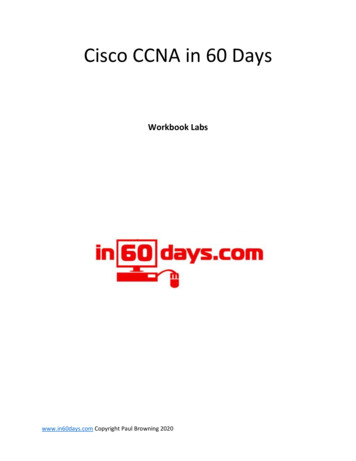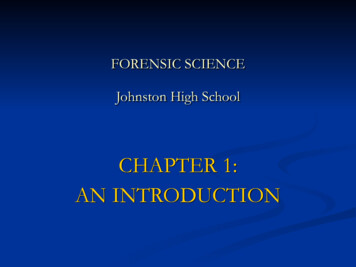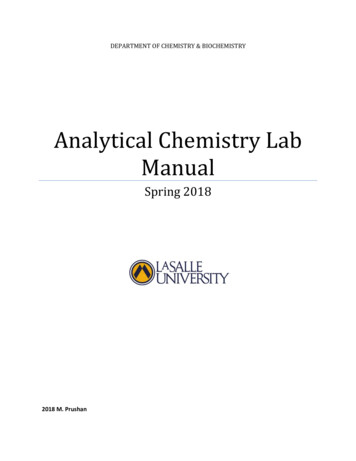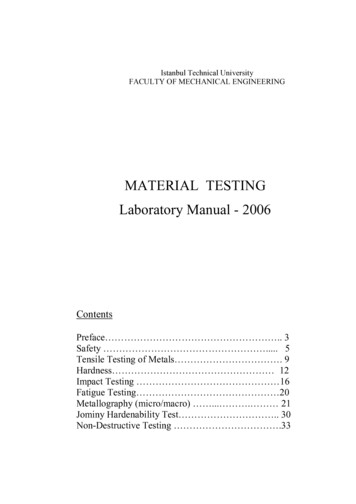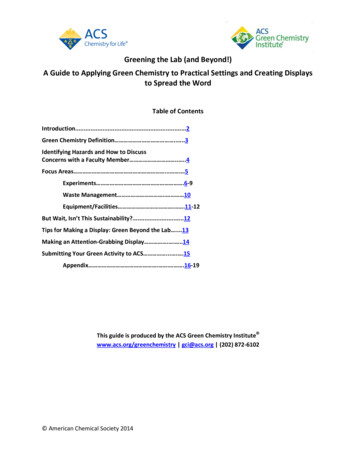
Transcription
Greening the Lab (and Beyond!)A Guide to Applying Green Chemistry to Practical Settings and Creating Displaysto Spread the WordTable of ContentsIntroduction.2Green Chemistry Definition . .3Identifying Hazards and How to DiscussConcerns with a Faculty Member . .4Focus Areas . . 5Experiments .6-9Waste Management . 10Equipment/Facilities . .11-12But Wait, Isn’t This Sustainability?.12Tips for Making a Display: Green Beyond the Lab .13Making an Attention-Grabbing Display . . .14Submitting Your Green Activity to ACS . . .15Appendix . . .16-19This guide is produced by the ACS Green Chemistry Institute www.acs.org/greenchemistry gci@acs.org (202) 872-6102 American Chemical Society 2014
2ACS GCI Student Chapter GuideNot all chemistry laboratories are created equal. Broken fume hoods, confusing waste beakers,and distillations that have been running (as far as anyone can tell) since the lab bench was installed arecommon occurrences among universities. But labs shouldn’t be so hazardous that they need to benavigated like minefields. This guide provides simple steps that your ACS student chapter can take tomake safer, greener lab spaces while educating other students and faculty about green chemistry.To Table of Contents
ACS GCI Student Chapter Guide3Sustainable and green chemistry in simple terms is just a different way of thinking about how chemistryand chemical engineering can be done. Over the years different principles have been proposed that canbe used when thinking about the design, development and implementation of chemical products andprocesses. These principles enable scientists and engineers to protect and benefit the economy, people,and the planet by finding creative and innovative ways to reduce waste, conserve energy, and discoverreplacements for hazardous substances.It’s important to note that the scope of these green chemistry and engineering principles go beyondconcerns over hazards from chemical toxicity and include energy conservation and waste reduction, aswell as life cycle considerations such as the use of more sustainable or renewable feedstocks anddesigning for end of life or the final disposition of the product.By incorporating sustainable and green chemistry into your student chapter’s activities you can: Become a spokesperson on your campus for sustainability and the solutions chemistry can bringthrough green chemistry Start a movement of sustainability across your campus and in the community Make a difference through chemistry Have a positive impact on human health, the environment & the future Improve the "image" of chemistryChapters who engage in at least three green chemistry outreach and educational activities during theschool year are eligible to win a Green Chemistry Student Chapter Award.Green Chemistry Themes to Consider1It is better to:Prevent waste than to treat or clean up waste after it is formedMinimize the amount of materials used in the production of a productUse and generate substances that are not toxicUse less energyUse renewable materials when it makes technical and economic senseDesign materials that degrade to innocuous products at the end of their usable life1Middlecamp, Catherine, ed. Chemistry in Context: Applying Chemistry to Society. 8th ed. New York: McGraw Hill,2014. Print
ACS GCI Student Chapter Guide4What’s Wrong with this Picture?You might not see anything immediately concerning when looking at a lab. But consider this: if it’s thework area you’ve been taught to use and navigate since you first set foot in Gen. Chem. lab of coursenothing will seem amiss. The first step in greening the lab is identifying what can be improved and thenlearning how the principles of green chemistry can be applied in a practical setting.This document will focus on three “problem areas” that many colleges and universities contend withand which can be addressed by your ACS student chapter:1. Experiments2. Waste Management3. Equipment or FacilitiesBut first things first. Most universities and colleges won’t be comfortable with students going in ontheir own and changing their labs around – and with good reason. Lab equipment, chemicals, andmaintenance are expensive and can be hazardous. It’s important to work with chemistry departmentfaculty when greening your lab. Plus, your professors might become interested in integrating moregreen chemistry into their curricula or research. The faculty will ultimately be the ones deciding whatand how labs are conducted so approaching these changes gently – and smartly - is essential.How to Bring it up with Your Professor2If the faculty member you’ve chosen to speak with about making changes in the lab has neverheard of green chemistry, you’ll want to ease in to the conversation. Jumping right in to all the ways youwant to change their space might seem intrusive, pushy, or overwhelming. Remember, they’re busy,too! Schedule a time to meet with them so they’re sure to be free and start first by defining greenchemistry and why it’s important, if they’re unfamiliar with it. Note how easy it is to make changes thatwill benefit everyone including members of the faculty. Explain how any associated costs will be coveredor, if you’re requesting funds from the department, say how much and precisely what they will be usedfor. Start slow, start small.There is an art to persuasion. Here are few tips for successful communication:1. Be logistic specific. What changes would you like to be made and when, how much will theycost, and what help do you need from the faculty?2. Stay focused. This is not about upcoming tests, how the cafeteria should recycle more, orpolar bears in the arctic. It’s about making changes to university labs so that they will bemore efficient and safer for students, faculty, and the environment.3. Go confidently with specific examples and details (provided in this document). Be able toexplain why what you’re doing is important without being vague or generalizing.4. Explain how the changes will benefit whomever you’re speaking with. A better image for thedepartment? An opportunity to be a leader on campus? Grants? Remind him or her that it’snot something else to squeeze into an already packed curriculum but painless substitutionsthat teach the same ideas and concepts with slightly altered methods.5. Don’t focus on what’s bad about existing labs – this approach might come off as accusatoryor insulting to their role and experience as a teacher. Focus on positive outcomes.6. Get a commitment. Create a timeline for the proposed changes. Show your appreciation.7. As with anything be determined but also considerate, respectful, and listen to what theperson you’re talking to has to say, as ault/files/Promoting Sustain Behavior Primer.pdf
5ACS GCI Student Chapter GuideFocus AreasSome universities and colleges have programs in place to improve the safety and sustainabilityof their chemistry labs.Universities with well-established green lab programs include:Cornell UniversityUniversity of Wisconsin Green BayUniversity of British ColumbiaUniversity of California at BerkeleyHarvard UniversityAdditionally, My Green Lab provides information on how to create sustainable labs.If you’ve talked to your professor or student chapter advisor and found that your institution doesn’thave such a program in place, don’t fret! It’s a big undertaking to green a lab, especially if the facility issomewhat outdated.This document focuses on examples of potential improvements of the chemistry laboratory in threeareas: experiments, efficiency, and waste.Because greening a lab can be an extensive task just choose either one area (suggested below) or oneactivity in each area and report on three changes that are made. Pair the in-lab work with a displayabout green chemistry and what’s been going on in the chemistry department to really round out thisgreen chemistry activity.Choose an area of focus:A) Greener ExperimentsB) Making the Lab More EfficientC) Improving Chemical Waste ProceduresTo Table of Contents
ACS GCI Student Chapter Guide6Undergraduate chemistry students have been doing the same labs in the same ways fordecades. Updates to clock reactions, titrations, extractions, and other classic teaching experimentshave not been widely implemented despite the use of hazardous solvents, overly reactive reagents, andunnecessary waste generation.Greening a lab requires complex considerations. Even micro-scale techniques, which are intended tobe more environmentally friendly by reducing the amounts of chemicals used, pose an inherent risk ofexposure due to the nature of the chemicals used, even if only in small amounts.3The examples of easy swaps in this section can be integrated on a wide scale into undergraduatecourse curricula. Of course this involves faculty time and serious commitment. Although you’ll needfaculty approval and support to make changes in the lab, it’s up to you and your ACS chapter tocommunicate the importance of transitioning. Use the examples below to help support a case forgreening the lab.3Singh, M.M., Szafran, Z., Pike, R.M. Microscale Chemistry and Green Chemistry: Complementary Pedagogies J. ofChem. Ed., 1999 76 (12), 1684 http://pubs.acs.org/doi/pdf/10.1021/ed076p1684
ACS GCI Student Chapter Guide7Alternative SolventsEven in undergraduate labs, hazardous solvent use is very common. A solvent must first of all functionwell, i.e. it needs to be an effective medium in which to carry out a reaction. However, there are safersolvents for human health and the environment that work as effectively as traditional solvents. It’ssimply a matter of making the switch.SolventAlternativeDry ice/acetoneDry ice/isopropanolHexaneHeptane, PentaneTHF2-MeTHFNo Solvent (solid state orreagents as solvents (i.e.melted reagents))4ExplanationIsopropanol is the safer solvent to use incooling baths as it works at about the sametemperature while being less volatile,meaning a reduced risk ofinhalation/exposure4Heptane is much less toxic than hexane(which is neurotoxic) while maintaining verysimilar chemical properties.52-MeTHF is derived from renewableresources like sugarcane and corn, while THFis petroleum-based. In addition, 2-MeTHF is acost-stable product that can also increasereaction yield while being easier to recycle6Solvent-less reactions can be used in a varietyof applications. Specifically in the organicchemistry lab, this is effective for aldolcondensations (forming een/ yday%20Lab%20Work%20Greener.pdf5Takeuchi Y., Ono Y., Hisanaga N., Kitoh J., Suguira, Y. A comparative study on the neurotoxicity of n-pentane, nhexane, and n-heptane in the rat. Brit. J. Ind. Med. 1980 (37), MC1008702/pdf/brjindmed00067-0029.pdf6D. F. Aycock , Solvent Applications of 2-Methytetrahydrofuran in Organometallic and Biphasic Reactions. Org.Process Res. Dev. 2007, 11, 156 159 ee, K.M., Hutchinson, J.E. (2004) Green Organic Chemistry: Strategies, Tools, and Laboratory Experiments,Brooks/Cole Cengage Learning: University of Oregon
ACS GCI Student Chapter Guide8Alternative ReagentsAlthough the conventional reagents for many organic syntheses are highly effective, they also poseunnecessary health and/or environmental risks. Often, less reactive, less toxic chemicals work as well astheir hazardous counterparts.8 Consider where alternatives might be of use in your university or collegelabs.Reagentm-chlorobenzoic acid, tinhydrideMetal ox reactions are often initiated with hazardousor precious chemicals. In this example, non-toxic,environmentally friendly electrochemistry allowsfor “oxidation of olefins to epoxides and reductionof vinyl halides to olefins”9LightMetal catalysts are often used to produce radicalreactions. However, some of these metals arescarce or toxic elements. Light is essentially theperfect green reagent: completely renewable,pollution-free, and effective. Solid supports inphotochemistry can often be recycled resulting ina high atom economy.10Alternative FeedstocksMany chemical feedstocks are derived from non-renewable fossil fuels. Biomass-derived products arenot only renewable but also provide a great variety of selective compounds. Additionally, unlike thewaste products of fossil fuel extraction and production, biomass wastes can be utilized such as inpharmaceuticals and generally have low-toxicity. Of course, it’s important to remember that evenpromising bio-based feedstocks fall into gray areas, including the environmental effects of growing theplants necessary for the supply (water use, fertilizer, pesticides, etc.)11Talk to a faculty member at your college or university about ordering chemicals from a company thatuses bio-based feedstocks instead of fossil fuel derivatives.8FeedstockBio-based AlternativeCrude Oil-derived succinic acidCorn-derived succinic acidExplanationA bacteria ferments glucose from cornto create succinic acid, a chemical usedin the manufacture of 1,4-butanediol,THF, N-methyl pyrrolidinone and more12Doxsee, K.M., Hutchinson, J.E. (2004) Green Organic Chemistry: Strategies, Tools, and Laboratory Experiments,Brooks/Cole Cengage Learning: University of Oregon pp.79-959http://cfpub.epa.gov/ncer ail/abstract/951/report/F10Jack, Lorna. 2005. “Green Chemistry’s Shining Light,” Royal Society of Chemistry; Chemistry 5/January/shininglight.asp11Doxsee, K.M., Hutchinson, J.E. (2004) Green Organic Chemistry: Strategies, Tools, and Laboratory Experiments,Brooks/Cole Cengage Learning: University of Oregon pp.97-9912Doxsee, K.M., Hutchinson, J.E. (2004) Green Organic Chemistry: Strategies, Tools, and Laboratory Experiments,Brooks/Cole Cengage Learning: University of Oregon p.98
9ACS GCI Student Chapter GuideAdditional Resources for Greener ExperimentsTwo ACS publications, Introduction to Green Chemistry and Greener Approaches to UndergraduateChemistry Experiments, provide green chemistry activities and labs and can be ordered online here andhere.The Green Chemistry Initiative based at the University of Toronto provides a wealth of information onalternative solvents, reagents, and more. Check it out here for more examples on easy lab swaps.In addition, a database called Greener Education Materials for Chemists (GEMs) and an initiative calledBeyond Benign also provide labs, some of which can be downloaded for free while others include anoverview and the source where they can be found (such as a textbook).For more chemical and process alternatives, also check out MIT’s green chemistry wizard.A few more alternative chemistry labs can be found in these locations:TitleDescriptionDoes Makes the Poison:Estimating the RelativeEcotoxicity of VariousBiofuelsA 3-part lab thatincludes synthesizingbiofuel, assessingpotential hazards, andwriting a short paper onalternative fuelsOrganizationContactRelevant Link(s)NotesBCGC,University ofCaliforniamarty lt/files/GreenChemistry Biofuels Unit.pdfundergraduate lab topics:heat transfer, toxicology intro,dilutions, stoichiometry,limiting reagents, reactionyield & efficiencyCandy Chromatographycandy chromatographyexperiment teachingbasic lab techniques:solutions andchromatographyScifun.org,University candy.htmmiddle/high school; other"home experiments" thatintroduce basic topics LSuper Gelatin: TeacherLesson Plan"students investigatethe refraction propertiesof gelatin to calculate itsindex of refraction "University ofTexas perGelatin.pdfprimarily a duate research symposium/2013/Sciences/26/uses hexane may be a goodexample of howimplementing one or twogreen principles may notmake the overall processgreenerGreen Chemistry: ThreeStep Synthesis ofAcetaminophendownloadable labprocedure with a few"green" changesSt. CatherineUniversitySolventless Syntheses ofMesotetraphenylporphyrin: new experiments fora greener organicchemistry laboratorycurriculumtwo solvent-freesyntheses that areintended for teachingundergraduate greenchemistry labsRSC, Universityof OregonTo Table of g/en/content/articlehtml/2001/gc/b107999a
ACS GCI Student Chapter Guide10What actually happens to the guck in those waste beakers? You know the ones – shoved into thecorners of fume hoods until one day they mysteriously disappear, hauled away in a truck with biohazardbumper stickers. Have you ever had a beaker full of solution at the end of a lab period and - a lab aidnowhere in sight - decided “this can probably just go down the sink”? Most students don’t question thedisposal of chemicals used in lab. Even if safer alternatives are employed, as mentioned in the abovesection, measures should still be taken to ensure that materials are disposed of responsibly. Many labshave too few disposal beakers, place the ones they have in sinks, give them improper labels, or providestudents with minimal instruction on waste disposal practices.13 Remember, nothing is ever just thrownaway – all chemicals end up somewhere after they leave the lab bench.Talk to a faculty member at your college or university about programs that can be put in place toensure that when waste must be produced it is safely and effectively managed.Waste Managementa. Establish a green lab certification program.i.What you need:i. Guidelines – how will the “greenness” of the lab be measured?ii. Checklist – a tool for participants to assess their labiii. Review Panel – an objective assessment team to observe lab practicesiv. The University of British Columbia is a great example of such a program.b. Recycling Solvents (adapted from the Green Chemistry Initiative at the University of Toronto)i. Solvents used to wash glassware is easily recyclable through distillation.ii. Solvents that are removed during rotovap/distillation can often be recycled ifpure or they can be re-used as wash solvents.c. Chemical Disposali. Even if your lab uses some greener alternatives there will still be risks involvedin the disposal and treatment of waste. Most colleges and universities havedetailed guidelines about waste disposal but students may forget or be unawareof them. Putting signs over sinks, ensuring waste beakers are properly labeled,and having a lecture on why waste disposal and prevention are important are allways to decrease the hazards associated with chemical wastes generated by alab.d. Chemical Exchange Programi. A number of universities have established programs through whichunused/unwanted chemicals can be obtained by other members of theuniversity rather than purchasing new chemicals. This not only saves theuniversity money but also reduces chemical waste.ii. This proposal from the University of California at Berkeley is great place to startfor detailed information on how to set up a chemical exchange program.e. Educationi. If you or other chemistry students have noticed a lack of instruction on chemicaldisposal procedures, talk to your professor or another faculty member aboutwhy your student chapter feels it’s an important topic to ch/watgreen/projects/library/820/final.html#formal
ACS GCI Student Chapter Guide11In those beginning-of-term safety videos, carelessness in the lab usually refers to things like pointingpipettes at your classmates, running between tables, or accidentally lighting something on fire. Butcarelessness can also refer to how energy is being used. Are fume hoods left running for weeks on end?Are faucets leaky? What kinds of light bulbs have been installed and do they ever turn off? In addition toenergy consumption, are the facilities where students spend hours every week actually safe?According to Harvard University’s Green Labs Program, labs make up 50% of their universityenergy consumption but only take up 23% of the space14. Here are a few common examples of sub-parlab practices and how universities have made improvements in safety and environmental impact.Efficiency of Equipment and/or Facilitiesa. Fume Hoodsa. Fume hoods require a huge amount of energy. The University of British Columbiaapproximates that 10% of the entire university’s energy consumption is from fumehoods alone15. One study estimated that a building with fume hoods requires fourto five times as much energy as a building without them (University of SouthFlorida).b. Shut the Sash! Campaigns and competitions are popular ways to save energy simplyby closing fume hoods. As an added bonus, keeping the hood open to a minimumdecreases the risk of exposure to chemicals. Students at the University of BritishColumbia put stickers up near the fume hoods reminding others that a fume hooduses as much energy as three homes.b. Faucetsa. As if water waste during experiments isn’t enough, many lab facilities haveinefficient faucets, such ones that leak. Turning off faucets when not in use andusing closed-loop cooling systems are easy ways to save water.b. Consider applying for a grant for the installation of motion-operated/automaticfaucets.c. Using less distilled water, such as when washing glassware, can save energy –regular tap water must be heated to boiling for purification.16c. Electronic efficiencya. Saving energy from lights and electronics is just about the easiest thing ever: simplyturn off the lights when not in use and shut down/sleep-mode computers ratherthan leaving them on for long periods of time. Your student chapter can put signs upnear computers and light switches to encourage these behaviors.d. Freezersa. Laboratory freezers, like fume hoods, are energy-intensive pieces of equipment.Harvard University suggests scheduling an annual “de-frosting” day.b. Leaving a one-foot space all the way around refrigerators/freezers allows thecooling mechanisms to work more /green-research/shut-the-sash16Buie, J. (2011). MindMap: Reduce My Lab’s Environmental Impact. Lab Manager Magazine, 6(3),70-71. Retrieved from: map-reduce-my-lab-senvironmental-impact#.U-t KfldVyw17Borchardt, J. K. (2009). Achieving Laboratory Energy Efficiency. Lab Manager Magazine, 4(3), 1619. Retrieved from: dVyw15
ACS GCI Student Chapter Guide12e. Applying for a grant to improve labsa. The EPA has awarded grant money for the improvement of educational facilities. 18b. DOW Chemical company provided a 3.5 million grant to the University of Californiaat Berkeley which was to be used in part to create greener lab spaces – otherchemical companies may offer similar opportunities19c. State governments and individual universities may also offer grants for greeninglabs, such as the state of Michigan’s Department of Environmental Quality.See the University of British Columbia’s virtual lab to view energy-saving changes in action.If you’re thinking, “But wait, this lab-efficiency stuff sounds like sustainability, not greenchemistry” you’re not wrong. Remember that green chemistry is a tool, along with manyothers, used to build a sustainable society. From a chemical perspective, energy consumption isoften a concern because of the material used to generate it. Fossil fuels have long been thestandard for meeting energy demands due to their relatively high energy output and low cost.However, these materials are non-renewable, the energy cost to extract them from the earth ishigh, and they release greenhouse gases when burned that would otherwise remain stored inthe earth. According to the U.S. EPA, “Fossil fuel-fired power plants are responsible for 70percent of the nation's sulfur dioxide emissions, 13 percent of nitrogen oxide emissions, and 40percent of carbon dioxide emissions from the combustion of fossil fuels. These emissions canlead to smog, acid rain, and haze.” Such processes as mining, drilling, and hydraulic fracturingfor extraction of non-renewable resources do not return safe substances to the environment aswould be preferred for a green chemistry process, but rather they input materials known to behazardous to ecosystems and which might pollute ground water. This kind of “upstreamthinking” is essential for green chemistry. All stages of a process – even if that process is assimple as flipping a light switch – should be considered. How can it be made better (a lab’s setup, a chemical synthesis, a solvent choice, etc.): i.e. less costly, less hazardous, and lesswasteful?To Table of chemistry.php
13ACS GCI Student Chapter GuideMaking a Display – Getting Green Beyond the LabAs much of an accomplishment it may be to implement greener lab practices, very few studentsor faculty will be aware of any change if they are not involved with the chemistry department. Take youractivity one step further and create a display or visual that tells everyone on campus about what’s beendone and why it’s important.The student chapters at the University of Texas at Tyler, the University of St. Francis, AugustanaCollege, Alvernia University, and the South Texas College all created unique educational displays aboutgreen chemistry. Several listed the 12 Principles of Green Chemistry along with their explanations andsome information on the importance and role of each principle. Some displays included information onways green chemistry is relevant both in research and to everyday life, including examples such as theones in Appendix A of this document. Of course, displays relating to changes made in the lab shouldhave information about what has been done and why it’s important to all of the non-chemistrystudents.
14ACS GCI Student Chapter GuideMaking an Attention-Grabbing DisplayDisplays can be more than just posters. The student chapter at Augustana College made a giantcrossword puzzle about the 12 principles of green chemistry as described by the ACS. Visualrepresentations of environmental and health impacts can be more powerful than posters. This E-factorvisualization from Gordon College and this hands-on biomagnification activity are great examples of outof-the box displays. Be creative!For posters, bulletin boards, and other flat displays there a few things to keep in mind. Create an outline first. Don’t just start gluing things on. Start the “story” in the upper left hand corner: put information here on what green chemistry is,followed by examples of why it’s important in everyday life, and only then continue across theboard to details about what changes are being made in your college or university labs Make sure the fonts are large enough (16 ) for both the title and the text Keep it neat: use rulers, a consistent coloration, printed rather than hand-written information,glue sticks, etc. for a professional appearance. There may be a printing facility on campus thatprints large posters. Set up in a high traffic area. Since the display is for a general audience consider somewhere likea dining hall where people will have time to read. Include visuals but make sure they’re not too small. Use the tools that are available to makeyour poster really stand out – do you have access to Photoshop, InDesign, Adobe Illustrator,etc.? Creating unique images and designs is fun and more likely to engage passers-by. Keep it simple – i.e. putting everything on a poster will crowd it. Students at the University ofTexas at Tyler highlighted two green chemistry principles a week instead of trying to cover themall at once. As with anything, don’t wait until the last minute to put it together Are you able to set up a table with your display? Members of your student chapter could taketurns talking to students about the display. Put out a bowl of free candy. Seriously. Neverunderestimate the power of free food. Reference any information you use, including images if they’re taken from the internetTo Table of Contents
15ACS GCI Student Chapter GuideSubmitting Your Green Student Chapter ActivityOnce your ACS student chapter has completed a green activity it’s time to fill out the student reportwith details about what’s been done. Feel free to send along photographs or a mention of your work inthe university or college news.See this webpage for information on deadlines, submission requirements, and the report form.In addition, find ways to quantify the changes your student chapter has made. If a chemical exchangeprogram is set up, how many grams of chemicals have been saved? If repairs are done on fume hoods,how many have been fixed? What are the energy savings? Please report as much quantified data aspossible to increase the likelihood of receiving an ACS Green Student Chapter Award.
ACS GCI Student Chapter Guide16Appendix A: Everyday Examples of Green Chemistry 20Below are some interesting examples of how green chemistry affects everyone. 20Have you ever had you clothes dry-cleaned? 21o Dry Cleaning: dry-cleaning processes have conventionally used the chemicalperchloroethylene (perc). Several organizations have stated that perc is ahazardous substance to human health. The International Agency for Researchon Cancer (IARC) conclud
activity in each area and report on three changes that are made. Pair the in-lab work with a display about green chemistry and what’s been going on in the chemistry department to really round out this green chemistry activity. Choose an area of focus: A) Greener Experiments B) Making the







